A History of the County of Bedford: Volume 2. Originally published by Victoria County History, London, 1908.
This free content was digitised by double rekeying. All rights reserved.
'Parishes: Hawnes or Haynes', in A History of the County of Bedford: Volume 2, ed. William Page (London, 1908), British History Online https://prod.british-history.ac.uk/vch/beds/vol2/pp338-344 [accessed 13 March 2025].
'Parishes: Hawnes or Haynes', in A History of the County of Bedford: Volume 2. Edited by William Page (London, 1908), British History Online, accessed March 13, 2025, https://prod.british-history.ac.uk/vch/beds/vol2/pp338-344.
"Parishes: Hawnes or Haynes". A History of the County of Bedford: Volume 2. Ed. William Page (London, 1908), British History Online. Web. 13 March 2025. https://prod.british-history.ac.uk/vch/beds/vol2/pp338-344.
In this section
HAWNES or HAYNES
Hagenes (xi cent.); Haunes (xiii cent.); Haine (xiv cent.); Haunce (xv–xvii cents.).
Haynes is a small village one mile east of the Bedford and Luton main road, and stands on high ground on the southern boundary of Haynes Park, most of the houses of the village lying along the road which branches off from the Bedford Road, and being known as Church End. Other groups of houses are Northwood End and Silver End, in the north-east of the parish, and West End on the Bedford Road, in the southwest. The church is close to the south entrance to the park, with the vicarage near by on the south, between it and the road. The open grass land of the park slopes down from the churchyard to the stream, a tributary of the Flitt, which flows eastward and forms a small lake.
The area of the parish is 2,606½ acres, of which 1,649¼ are arable land, 1,277½ permanent grass, and 72½ woods. (fn. 1) The soil is of clay and sand, and the subsoil is of Lower Greensand formation. The chief crops are wheat, barley, beans, and turnips. The ground is very undulating; the highest point, 373 ft. above ordnance datum, being found in the south of the parish, while the lowest point, 193.8 ft., is at Appley Corner, on the border of Southill parish.
Haynes Park is well placed on the northern slope of the valley through which the stream runs, but the house is in itself of little architectural interest, having been much modernized. It is at present occupied by Mr. W. B. Greenfield. The collection of portraits of Grenvilles, Carterets, and Thynnes, is a notable one; among others are Sir Richard Grenville, dated 1571; Sir Bernard, his grandson; and Sir Bevil, his great-grandson, the great west country royalist, killed at Lansdowne in 1643; Sir John Grenville, son of Sir Bevil, and first earl of Bath; Sir George Carteret, Governor of Jersey; Edward Montagu, first earl of Sandwich; Robert, earl of Essex, Elizabeth's favourite; and Margaret, countess of Lennox, Darnley's mother.
Among the place-names in this parish occur those of Hubbards Pightells, and Hare Stockingfield, as the names of closes belonging to the manor of Franklins in 1681. (fn. 2) In 1584 Sir Robert Newdigate died seised of a close called Purleies Close or Julian's Grove, parcel of the manor of Haynes: (fn. 3) the name St. Julian's Grove still survives in the parish. In 1622, when the manor was sold to Sir Oliver Luke, he received with it two closes called Fattinge Pasture, and Westmires, and also a close called Collens Close, (fn. 4) which is also mentioned in 1584, as parcel of the manor. (fn. 5)
A ring stated to be identical with the one given by Queen Elizabeth to the earl of Essex was in the possession of Lord John Thynne at Haynes, and was said to have been inherited by him through Essex's daughter Frances, but there is no foundation for the story. (fn. 6)
Haynes was once the scene of a royal visit, when Sir Robert Newdigate was lord of the manor, and on 27 and 28 July, 1605, Queen Anne, the wife of James I, was entertained by him at Haynes, the king being then at Sir Edmund Conquest's at Houghton. On the 30th, the royal pair, with the whole court, attended divine service at Haynes church. (fn. 7)
Manors
From the time of the Great Survey, the manor of HAYNES was held of the king in chief. The last mention of the overlordship occurs in 1614. (fn. 8)
In 1086 the manor was held by Hugh de Beauchamp and was assessed at; hides. It had been held by Achi, a thegn of King Edward. (fn. 9) Hugh's eldest son Simon died without issue and the second son Pain, who obtained the barony of Bedford from William II, inherited the manor, which on his death descended to his son Simon. (fn. 10) The latter died about 1206, leaving as his heir a son William, who in 1219 was concerned in a dispute with Robert de Bray over land in Haynes. (fn. 11) On his death in 1259 the manor passed under (fn. 12) a settlement of 1257 to his second son Henry, who, however, did not live long to enjoy the property, for he died some time before the year 1265, leaving no children and the manor became the right of his brother John, who was killed in 1265 at Evesham, in arms against the king. The manor then passed to Maud, sister of John, who married Roger de Mowbray as her first husband, by whom she had a son Roger. She married as her second husband Roger Lestrange, (fn. 13) who in 1286 claimed view of frankpledge in the manor of Haynes in right of his wife. (fn. 14) Roger survived his wife and on his death in 1312 the manor passed to Maud's grandson John, son of Roger de Mowbray, who had died in 1296. (fn. 15) John married Aliva, daughter and coheir of William de Braose, and in 1315 settled the manor on his father-in-law for life. (fn. 16)
John joined the insurrection of Thomas, earl of Lancaster, in 1321 and having been made prisoner at the battle of Boroughbridge, he was hanged at York in March, 1321–2. (fn. 17) The same year Edward II granted the reversion of the manor held by William de Braose to Hugh le Despenser and Eleanor his wife. (fn. 18) William de Braose died before the end of the year and Hugh and Eleanor were granted in February, 1325–6, free warren in the demesne lands of the manor of Haynes. (fn. 19) Edward III on his accession, however, restored the manor to John de Mowbray (whose father John de Mowbray was hanged at York), who in that year came of age. (fn. 20) John's mother Aliva had married, as her second husband, Sir Richard Peshall, who seems to have enjoyed the manor of Haynes in the right of his wife who died in 1381, for in 1329 and again in 1332, Sir Richard Peshall complained that his stepson had broken his manor of Haynes and carried away oxen and cattle, besides mowing his crops, fishing in his streams, and carrying away the crops and fish. (fn. 21) John de Mowbray was a distinguished soldier, and earned great renown in the wars with France. He died of the plague in 1361 and was succeeded by his son John. (fn. 22) The manor was held for life, however, by his widow Elizabeth, (fn. 23) who in 1366 was called upon by her son John to show by what right she had prepared to sell or destroy three houses, woods and gardens in Haynes and Willington, which with the manor were to revert to him after her death. (fn. 24) John recovered the site of the manor and park by grant of waste against Elizabeth and also was awarded as damages £23 annually for twenty years to be paid out of the manor of Haynes. This John de Mowbray married Elizabeth daughter and heir of John Lord Segrave by Margaret his wife daughter and heir of Thomas, earl of Norfolk and marshal of England. (fn. 25) He joined the crusades and was killed by the Turks near Constantinople in 1368, leaving a son John, who was then three years old. (fn. 26) His father's widow Elizabeth died in 1376 (fn. 27) when the custody of the manor of Haynes was committed to trustees during the minority of the heir. (fn. 28) The damage in the manor of Haynes was such that the jury did not think the necessary repairs could be undertaken for less than £100. (fn. 29) The next year John de Mowbray was created earl of Nottingham, but died in 1383 while still under age, when his brother Thomas inherited the manor which was then worth £16. (fn. 30) In the same year Thomas was created earl of Nottingham, as that title had died with his brother, and in 1389, marshal of England for life, while in 1397 he was created earl marshal and duke of Norfolk. (fn. 31) He was banished from England the next year and died at Venice, 1400, (fn. 32) in debt to the king and without having accounted for sums of money spent in the defence of Calais. (fn. 33) He left a son Thomas, then a minor, and a widow Elizabeth who married, as her fourth husband, Sir Robert Goushill, to whom she brought the manor in dower. At his death in 1404 the manor was valued at £10 only. (fn. 34) Thomas was beheaded the next year, having joined in the Scrope conspiracy, and the reversion of the manor passed to his brother John (fn. 35) who entered into possession in 1425, on the death of Elizabeth his mother. (fn. 36) John took an active part in the French wars and died 1432. (fn. 37) His son John died in 1461, leaving as his heir a son John, (fn. 38) created earl of Surrey and Warenne in his father's lifetime. On his death in 1475–6 the manor passed to his daughter Anne who married Richard Plantagenet, duke of York. She died while still an infant in 1480–1, and Haynes passed to her co-heirs, William earl of Nottingham and Thomas earl of Surrey, who were the descendants of her great grand-aunts, the daughters of Thomas Mowbray, first duke of Norfolk, who was banished in 1398. Isabel the elder of these had married James, Lord de Berkeley, and by him had a son William, created earl of Nottingham in 1483; the younger, Margaret, married Sir Robert Howard, and their second son Thomas, in 1483, was created earl of Surrey. (fn. 39)
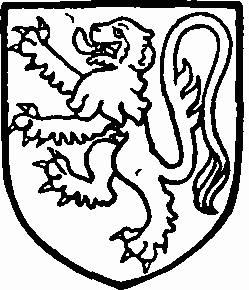
Mowbray. Gules a lion argent.
William earl of Nottingham, and Anne his wife, in 1488 alienated their share of the manor to Sir Reginald Bray, (fn. 40) who acquired the other moiety of the manor in 1491 from Thomas, earl of Surrey, and Elizabeth his wife. (fn. 41) Sir Reginald Bray died in 1509 and the manor became the subject of a dispute between Margery wife of Sir William Sandys, afterwards Lord Sandys, and daughter of Sir John Bray, a half-brother of Sir Reginald Bray, and Edmund Bray, afterwards Lord Bray, son of John, another brother of Sir Reginald. (fn. 42) The quarrel was settled in 1510 and Edmund retained Haynes manor, Margery obtaining manors elsewhere. (fn. 43) Edmund died in 1539, (fn. 44) and was succeeded by his son John, Lord Bray, who married Anne daughter of Francis earl of Shrewsbury. He died without issue in 1557, appointing his mother Jane, daughter and heir of Richard Haliwell, his sole executrix. Jane had married, as her second husband, Sir Urian Brereton of Handforth, Cheshire, but she did not survive her son long, as she died in 1558. (fn. 45) According to a settlement made by Edmund Lord Bray in 1538, (fn. 46) the manor, on the death of John, passed to this Edmund's brother, Sir Edward Bray, but he also dying in 1558 it was inherited by his son Sir Edward. (fn. 47) The latter in 1564 conveyed it to Robert Newdigate, (fn. 48) but the total alienation of the manor could not take place until Sir Edward's son and heir Reginald was of full age. The completion of the purchase was, therefore, not effected until 1580, when Sir Edward Bray and Mary his fourth wife, with Reginald his son and heir by his second wife Elizabeth, sold the manor to Robert Newdigate. (fn. 49) The manor of Haynes remained in the possession of the Newdigate family for nearly half a century. The original purchaser Robert died seised of it in 1584, when it was worth £20, Robert having acquired, shortly before his death, a third of the manor, which was held as dower by Lady Anne Wharton, who died in 1585, the widow of John Lord Bray. (fn. 50) He was succeeded by his son Robert, afterwards Sir Robert Newdigate, kt., who died in 1613, leaving a son Robert, the third of that name. (fn. 51) The latter in 1622 sold the manor to Sir Oliver Luke of Wood End, in the parish of Cople, (fn. 52) the father of Samuel Luke, knighted in 1624. (fn. 53) Both father and son were zealous Parliamentarians and strong Presbyterians and both sat in the Short Parliament of 1640, and in the Long Parliament, Sir Samuel Luke as member for Bedford Borough, and his father representing the county. At the Restoration Sir Samuel Luke also sat in the Convention Parliament as member for Bedford Borough. He took an active part in the Civil Wars and was several times wounded and taken prisoner. His personal appearance and short stature made him an object of Royalist satire and he was the original of Butler's Sir Hudibras. (fn. 54) During these disturbed times (fn. 55) he seems to have settled the manor on his son Oliver, who had married Elizabeth the daughter of Onslow Winch, (fn. 56) and in 1667 father and son united in conveying the manor to William Montague and Sir Thomas Crewe, father of John Crewe, Lord Crewe of Sterne, (fn. 57) probably a preliminary step to selling it to Sir George Carteret, for although no record of the transfer is extant, it was acquired by the Carterets about this time, and Lysons mentions 1667 as the date. Sir George Carteret was a devoted adherent to the Royalist cause, he had defended Jersey against the Parliamentarians, was created a baronet in 1645 and made vice-chamberlain at the Restoration. His son Sir Philip was blown up in the Royal James off Southwold Bay in the action against the Dutch, which took place there in 1672, leaving a son Sir George, who inherited the manor on his grandfather's death in 1679. The latter was a zealous supporter of the Revolution, although elevated to the peerage by Charles II in 1681, with the title of Baron Carteret of Haynes. (fn. 58) He died in 1695 and was succeeded by his son John who became Earl Granville on the death of his mother in 1744. (fn. 59) He led an active political life, being Lord-lieutenant of Ireland in 1724 and died in 1763. (fn. 60) The manor passed to his son Robert on whose death without issue in 1776 (fn. 61) it was inherited by his nephew Henry Frederick, younger son of his sister Louisa, in accordance with the terms of the will of John, Earl Granville. (fn. 62) Henry Frederick in 1784 was created Baron Carteret of Haynes with remainder to the younger sons of his brother Thomas, first marquess of Bath, and on his death without issue in 1826 the manor and title passed to his nephew Lord George Thynne, who died childless in 1838, when he was succeeded by his brother John, third Lord Carteret, who also died without issue in 1849. (fn. 63) The title then became extinct, but the manor was inherited by the Rev. Lord John Thynne, subdean of Westminster (third son of Thomas, second marquess of Bath), in whose second son, Mr. Francis John Thynne, it is vested at the present day.
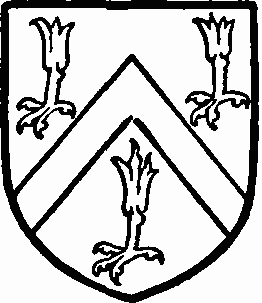
Bray. Argent a cheveron between three eagles' legs razed sable.
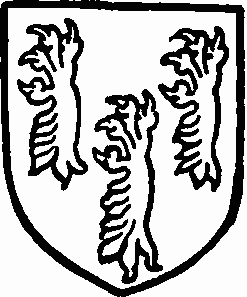
Newdigate. Gules three lions' paws razed argent.
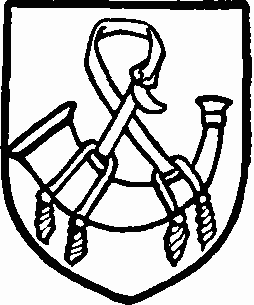
Luke. Argent a hunting horn sable.
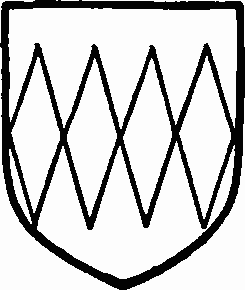
Carteret. Gules a fesse indented of four points argent.
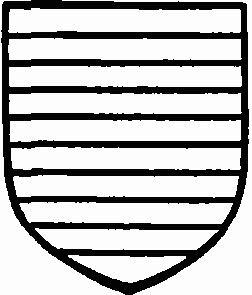
Thynne. Barry of ten pieces or and sable.
The site of the manor of Haynes was mortgaged in 1568 by Robert Newdigate, together with the park, for £300 by the name of 'the messuage or mansion house wherin Robert now dwells, known by the name of the site of the manor of Haunes or Haunes Lodge.' (fn. 64)
A windmill is mentioned as belonging to the manor in 1312, (fn. 65) but this is the only notice. A water-mill, however, was attached to the manor in 1689, (fn. 66) and in 1711 was called a water grist-mill. (fn. 67)
Park
A park at Haynes is mentioned for the first time in 1312, when Roger Lestrange, the husband of Maud de Mowbray, died seised of it, (fn. 68) and it has always been attached to the manor. In 1316 William de Braose complained that his park had been entered by many men who hunted and carried away the deer, (fn. 69) and in 1327 it was estimated to contain 240 acres. (fn. 70) It was stated in 1368 that the park was worth nothing beyond reprises because the underwood there was insufficient for inclosing it. (fn. 71) The office of parker was conferred upon William Marshall in 1393 for life, with the fees, to hold as Roger Park, deceased, had it, and in 1398 he received the profits of agistment and herbage, provided that sufficient pasture should be kept for the deer of the lord of the manor. (fn. 72) In 1568 the park was mortgaged by Robert Newdigate, and contained then about 500 acres. (fn. 73) At the present day the park is about 800 acres in extent, and is very well timbered, although there are no trees of particular note beyond a number of cork oaks, some large hollies and ilexes.
There was another manor in the parish known by the name of HAYNES GRANGE, which is first mentioned in 1150, when it was presented by Pain and Rose de Beauchamp to the priory of Chicksands, on the occasion of the foundation of that monastery. In the grant were included 400 acres, and the whole of Applewood except the part which Olaf the priest of Haynes held. (fn. 74) This grant was confirmed in the reign of Henry III by William de Beauchamp, greatgrandson of the donor, (fn. 75) and the priory continued in undisturbed possession until the Dissolution. In 1285 free warren in Haynes was bestowed upon the priory, (fn. 76) and the value of the Grange about 1291 was £5 12s. (fn. 77) The holding was augmented in 1308 by an alienation in mortmain of 40 acres, the gift of Robert Doket of Wilshamstead, (fn. 78) but in 1325 the priory was involved in serious monetary difficulties, and mortgaged Haynes Grange and the chapel of St. Thomas' manor in Meppershall to John Pisaquila of Genoa, and Bartholomew Riky, besides having to sell Applewood and another wood called Inwood; the mortgage, however, (fn. 79) was gradually redeemed, and in 1327 a yearly rent of 77s. 6d. was granted to the priory by Robert de Flamville. (fn. 80) In 1330 the priory justified its claim to free warren in Haynes by the production of the charter of Edward I, and also to view of frankpledge held twice a year in the manor by prescriptive right. (fn. 81) At the time of the dissolution of Chicksands, the priory's estate was worth £9 12s. 8d. (fn. 82) Henry VIII in 1544 granted the manor to Henry Audeley and John Maynard and their heirs, (fn. 83) but it was probably soon acquired by Richard Snowe and Elizabeth his wife, who had already obtained in 1540 the manor of Chicksands, and all lands in that parish belonging to the dissolved priory. Richard Snowe died in 1553 seised of a messuage and lands in Haynes, (fn. 84) and his son Richard in 1587 alienated the Grange to Peter Osborn at the same time that he sold him Chicksands manor. (fn. 85) Since this date the manor has remained in the Osborn family, and its history has been identical with that of the manor of Chicksands (q.v.). The present representative of the family, in whom the manorial rights are vested, is Sir Algernon Kerr Butler Osborn, bart.; the manor is now known as the Grange Farm House, and is situated about half a mile south-east of the village. In shape it is like the letter H, of which the central portion and east wing have been rebuilt at a comparatively recent date. The old west wing of half timber contains a fine old staircase, leading to a spacious apartment, in which there is a large open fireplace.
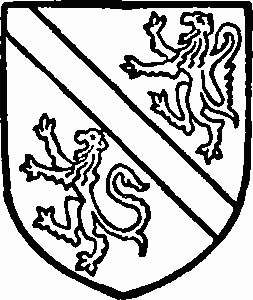
Osborn, Baronet. Argent a bend between two lions sable.
Applewood and Inwood, which were sold by the priory in 1325 in order to raise money, were apparently regained and followed the same descent as Haynes Grange, for Sir John Osborn died seised of them in 1628. (fn. 86) Another wood called Auferney was reserved to the crown when Henry Audeley received Haynes Grange in 1544, but the Snowes were holding it in 1587, and it passed to the Osborns. The name Apple still survives in Appley Corner.
The manor of FRANKLINS probably owed its name to the family of Franklin, for in 1463 a protection granted to John Franklin of Haynes for one year, to go to Picardy on the king's service, was revoked as he delayed in Westminster on his own business. (fn. 87) No other record of this family, however, is found relating to Haynes, although the Franklins were landowners in Thurleigh. The manor of Franklins is first mentioned in 1563, when Sir John Gascoigne and Margaret his wife and their son and heir George conveyed it to Peter Grey, (fn. 88) who sold it in 1564 to Simon Leaper and Katherine his wife, an arrangement being made by which the purchase money was to be paid in the form of a rent for a certain number of years, and in 1570 an action was brought against the latter for refusing to pay the rent after her husband's death in 1568. (fn. 89) The manor passed to Thomas, son of Katherine and Simon, and he, on the occasion of his son Thomas's marriage with Judith Saunderson in 1601, settled it on them and their heirs. Thomas the father died in 1604, (fn. 90) and the son with his second wife Peregrine sold the manor in 1622 to Thomas Field, (fn. 91) who, two years later, with his wife Anne, conveyed it to Sir Oliver Luke, who had already purchased Haynes manor. (fn. 92) The manor continued to be held by the Lukes, and the last mention of it occurs in 1704, when Nicholas Luke was the owner. (fn. 93) From this date the descent of the manor is lost. (fn. 94)
Another supposed manor appears for the first time in 1623 under the name of the manor of THE CHAPEL OF SAINT MACUTES (alias St. Machutus, alias St. Makes, alias St. Marks). This estate owed its origin to the free chapel of St. Machutus in Haynes, said to have been given by Robert de Albini in the twelfth century to Beaulieu Priory, in the parish of Clophill, a cell to the abbey of St. Albans. (fn. 95) Although the priory had to serve the chapel and took the profits of the lands, the advowson appears to have been retained by Robert de Albini and followed a descent which is traced under the advowson of the church. On the occasion of the transfer of Beaulieu Priory to St. Albans Abbey without the king's consent in 1435, an inquisition was taken, in which it was stated that Aumary of St. Amand, a descendant of Robert de Albini, had shortly after 1279 given a carucate of land in Wilshamstead to support one monk in the chapel of St. Machutus, who should celebrate mass there three days a week for the souls of Aumary and his ancestors. During the eight years prior to this inquisition the abbot had ceased to provide a monk and had taken all the profits of the carucate which was worth £4. (fn. 96) The same abbot John of Wheathampstead undertook many expensive works on the lands belonging to St. Albans, and among others caused five barns to be built at St. Machutus in 1438, one of which, 48 ft. in length, cost £10. (fn. 97) The chapel and lands came to the crown at the Dissolution, and were afterwards bestowed by Queen Mary upon George Rotherham of Farley and Roger Barber of Luton, and were conveyed by them, towards the end of the same year, to John Ventris of Campton, to hold from the queen in chief. (fn. 98) John Ventris died seised of the manor in 1558 and was succeeded by his second son Henry, the elder, William, dying a few weeks after his father. (fn. 99) The lands and buildings were rented from the Ventris family by Edmund Lord Bray, and it was stated in 1561 that the lease had yet thirteen or fourteen years to run. (fn. 100) It is stated that George Rotherham died seised of the lands and chapel in 1594, and shortly before his death he brought an action against Anne Rotherham, widow, and Isaac Rotherham, from whom he claimed the lands and chapel by descent from his grandfather, George Rotherham, to whom they were granted in 1554; (fn. 101) none of the Rotherhams, however, had any claim to the lands and chapel, as they were alienated by the grantee George Rotherham to John Ventris, in whose family they continued for many years.
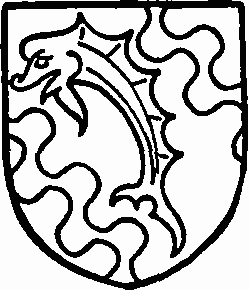
Ventris. Azure a dolphin swimming between two waved bends argent.
Henry Ventris died in 1564, and left as his heir a son Francis, then only a year old. He afterwards became Sir Francis Ventris, (fn. 102) and in 1623 conveyed the chapel and lands, by the title of the manor, to Robert Morgan of London, for the purpose of a settlement on his second son Charles. (fn. 103) However, on the death of Sir Francis in 1627, his eldest son Francis entered into the premises, (fn. 104) and on his death without issue in 1631 his brother Charles inherited the manor. (fn. 105) Some time between 1657 and 1666, the manor was alienated to the Luke family, who had acquired Haynes manor in 1622. (fn. 106)
The manor passed from the family of Luke to the Lords Carteret, its descent being identical with that of Haynes manor from the date of the transfer to the Lukes. The last mention of it occurs in 1795, when Henry Frederick, Lord Carteret, owned it, (fn. 107) the absence of all later mention of it doubtless indicates that it was absorbed in Haynes manor; the name however survives in a wood known as St. Macute's Wood.
Church
The church of OUR LADY was practically rebuilt except the tower in 1850, and has a chancel 35 ft. 6 in. by 15 ft. 6 in. with vestry and north chapel, nave 60 ft. by 20 ft. 8 in. with north and south aisles 7 ft. 8 in. wide, south porch, and west tower 10 ft. square within the walls. The oldest masonry details are those of the south arcade of the nave, which is good work of the early part of the fourteenth century, with tall pointed arches of two chamfered orders in the labels, piers of four engaged half-round shafts, and moulded capitals and bases of excellent detail.
The chancel and tower arches are both of fifteenthcentury date, their detail being similar. The chancel contains no ancient features, having a modern east window of three lights, two two-light windows on the south, a north window to the east of the vestry door, and an arcade of two bays opening to the north chapel which contains an elaborate monument of Anne Constantia (Beresford) wife of Lord John Thynne. On the south side of the chancel are modern sedilia and a recess for the organ. East of the vestry doorway is a small segmental-headed recess retaining a little ancient stonework.
The nave arcades are of four bays, that on the north being a modern copy of the south arcade. All the nave windows and the south doorway with its porch are modern. The western tower, which is roughly plastered on the outside, has an embattled parapet, plain two-light belfry windows, and a much-restored west window of two lights on the ground story. It has a stair at the south-east angle, and opens to the church by a pointed arch of two moulded orders with a hollow between, the jambs having in place of the hollow a rounded member which is continued vertically above the capital and dies out in the hollow, a curious and illogical detail characteristic of fifteenthcentury work in the district. This detail occurs also in the chancel arch. The roofs are entirely modern, that of the nave having at the plate-level figures of angels bearing emblems of the passion. The font is octagonal with plain fifteenth-century detail. At the east end of the south aisle is the Carteret chapel and vault, inclosed with a wroughtiron screen. On the north wall of the chancel is the brass of Anthony Newdigate, 1568, with a figure kneeling at a desk, and a shield of arms above.
There are four bells, the treble by John Knight 1627, the second by Christopher Graye 1662, the third is a fourteenth-century bell with a reversed inscription in Gothic capitals reading 'Matris Messie pie sum campana Marie,' and the tenor of 1658 bears three sets of initials 'C. G.,' 'T. T.,' and 'W. W.' reversed. The plate consists of a silver chalice and paten of 1849, given by Lord John Thynne.
The registers are contained in four books beginning respectively in 1596, 1654, 1664 and 1754.
Advowson
The church of Haynes is first mentioned in 1150, when it was given by Pain and Rose de Beauchamp to the priory of Chicksands on the occasion of the foundation of the latter. (fn. 108) The gift was confirmed by William, their grandson, in the thirteenth century, (fn. 109) and the church remained the property of the priory until the Dissolution. The vicarage was constituted before 1235 and appropriated to Chicksands Priory; it was then worth 4 marks, and the whole church 12 marks (£8); the prior had to provide a toft for the vicar, and to sustain all the charges of the church, while the vicar had to pay the prior 15s. (fn. 110) About 1291 the church was worth £6 13s. 4d. apart from the pension of the prior, which was £1 6s. 8d., while the 15s. from the vicarage was still paid. (fn. 111) The total value of the church in 1535 was again £8, so that the value remained the same during the whole period of 300 years. (fn. 112) After the dissolution of Chicksands Priory the advowson, with the rectorial tithes, was granted by the king to William Ardern, who had apparently had the lease of them in 1535, for in that year he interfered on behalf of Mr. Franklin, the parson of Haynes, who was cited by the bishop of Lincoln before his chancellor. William Ardern trusted the articles against Franklin would be found untrue 'for the parsonage is well and sufficiently reparelld, and in the same hospitality kept, and a priest to serve the cure.' (fn. 113) In 1544 Henry Audeley and John Maynard received a grant of the vicarage and tithes, (fn. 114) but by 1587 they were the property of Edward Snowe, who in that year alienated them to Peter Osborn and his heirs. (fn. 115) The advowson of the vicarage since that date has remained the right of the Osborn family, and has followed the descent of Chicksands manor, being vested at the present day in Sir Algernon K. B. Osborn, bart. The value of the vicarage in 1605 had not increased since 1235, but was still £8. (fn. 116) Thomas Brightman, the author of a thesis on the Book of Revelation, was then the vicar; his work attracted much attention in the reigns of Elizabeth and James. (fn. 117) In 1641 Sir Peter Osborn brought an action against Thomas Joyce, the parson of Haynes, and the latter was ordered by the House of Lords to produce his presentation and induction to the rectory. (fn. 118) He apparently was deprived of the living and compounded in December, 1646, under the Oxford Articles for delinquency, as he had gone to Oxford and joined the king. In March, 1647, he was subjected to the Decimation Tax and paid £28. (fn. 119) In the meantime another rector, John Bird, who had been inducted, proved unsatisfactory, and the rectory was sequestered from him in 1645 on account of misdemeanours certified against him. His successor, Mr. Tutty, left the next year for want of maintenance. (fn. 120)
The advowson of the free chapel of St. Machutus, granted in the twelfth century to Beaulieu Priory by Robert de Albini, was doubtless retained by him and passed by some unknown means into the family of Mowbray, to whom he was related, being a nephew of Roger Mowbray. (fn. 121) The advowson remained vested in the Mowbrays, and its history is similar to that of the manor of Haynes, (fn. 122) with which it was alienated in 1488 to Sir Reginald Bray. (fn. 123) The last mention of the advowson occurs in 1538 when the Brays were still the patrons, (fn. 124) but as all religious services in the chapel probably ceased when the abbey of St. Albans was dissolved the advowson of necessity lapsed.
Charities
There are here a Wesleyan and a Baptist chapel. In 1708 Villiers Fowler, widow, by will, charged her estates in the county of Bedford with the principal sum of £100, to be laid out in the purchase of land for the use of the poor, 50s. a year for teaching poor children, and the remaining portion of the income amongst the poor of the parish. A sum of £22 was also given by a poor sailor for the poor of the parish. The principal sum of £122 is regarded as charged upon Haynes Park Estate, now belonging to F. J. Thynne, esq., at £5 per cent.; 2s. 6d. each is paid to thirty widows or widowers on St. Thomas's Day, and the balance in prizes for knowledge of the Scriptures and for attendance at school.
James Eames by his will, proved 6 March, 1888, bequeathed £906 15s. 10d. consols (with the official trustees) the dividends of which are divided among twenty-five poor persons, who formerly received £1 a piece, but since the reduction of interest on the stock 18s. 2d. each.